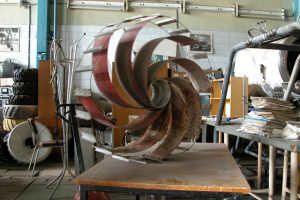Personalized Therapy of Cancer
Oncologist Justin Stebbing on targeted therapies, side effects of chemotherapy and how multidisciplinary appro...

Some people just mean ‘very very small’ when they speak of ‘nano’, however in science ‘nano’ means that the object is less than a micron in two or three dimensions. Is it possible to build a nanorobot of that size? How could nanorobots help us in diagnostics and treatment of different diseases? Serious Science asked Peer Fischer about nanorobots, why are they so hard to work on and what might be their future application in medicine.
The goal of nanorobotics is to incorporate robot functions, i.e. sensing, processing of information, some form of action and possibly communication at a scale that is much smaller than a single cell or a microprocessor. This is extremely challenging. Most synthetic nanorobotic systems are just simple particles that can only achieve some of these functions or need an external control system to do so.

One goal of nanorobotics is to develop new medical applications. In medical practice one already uses micro and nanoparticles: these are presently moved around the body by the bloodstream. The ‘nanorobots’ that people are trying to develop should actively move or be moved to a specific place. This would enable an entirely new form of targeted delivery. Thus, the distinguishing feature of a nanorobot is that there is some way of interacting with it, either by moving it, by switching it on or by reading something out.
Depending on the discipline, some people just mean ‘very very small’ when they speak of ‘nano’, similar to micro-surgery which can mean that the surgeon uses a microscope to look at something which could be several millimeters big. However, for a scientist ‘nano’ means that at least two (ideally three) critical dimensions are below a micron, i.e. smaller than one millionth of a meter (< 10-6 m). If all three dimensions are smaller than a micron, then the size of such a nanoparticle is comparable to the size of a large virus. However, it would be misleading to think that ‘nanorobot’ means that everything happens inside this particle and only happens on the nanoscale. A man-made micron or sub-micron sized structure that can sense its environment, process information, and act, i.e. function as an autonomous nanorobot does not yet exist. Often there is thus some large scale equipment on the outside that is needed for the robotic control. So, more correctly one should speak of nanorobotic systems.
One class of nanorobotic systems usually consists of particles and an outside controller. The particle in itself is typically very simple, i.e. a tiny piece of a material, but one that can be controlled with light, magnetic fields or acoustic fields. For instance, a nanorobotic system may consist of sub-micron particles that possess a magnetic moment and a macroscopic laboratory setup with which magnetic fields controllably steer them. There might also be an imaging system to track the particles. Recent work has shown, for instance, that it is possible to control and move a swarm of cork-screw like magnetic nanopropellers through biological tissues. In this case the nanorobotic systems consists of the nanopropeller particles and the auxiliary equipment used to both actuate and track them.
Another class of nanorobots does not use external fields and setups, but incorporates the ‘engine’ directly in the nanorobot. Now everything really happens within the nanoscopic particle, and this therefore makes for more autonomous systems. Imagine a simple micro- or sub-micron particle, typically a spherical one, that contains the correct drugs and is decorated with a catalyst or with enzymes on the outside, where chemical reactions take place. The reactions change the local chemical environment around the particle such that it can propel itself forward. A research goal is to design these chemically active particles such that they can actively move to a desired location, for instance to a place where there is a desired pH concentration.
Finally, there are also efforts to make use of living micro-organisms, such as bacteria. A bacterial cell can autonomously sense its environment, process information and act, and it may be integrated or combined with synthetic systems.
I would like to note that in none of these examples there is any hardware we would find in large-scale robots, i.e. no batteries or conventional motors: these components are only found in devices on the scale from hundreds of microns to millimeters.
One intended target is to assist with all aspects of potential medical procedures: to assist with diagnosis, treatment, surgery etc. For instance, if one is considering surgery, then the particle may be heated by a laser or an AC magnetic field and then used to destroy tissue. In the case of diagnostics it could be a particle that is made to deliver a contrast agent that can help with imaging. In the case of treatment, the particles might be loaded with a drug and steered to a location of interest (or actively move there by themselves). All three are subject of ongoing research and can already in part be achieved with passive nanoparticles.
To move nanorobots or to have them do some work you must be able to exert enough force, must be able to control them and must do that in an environment where it is generally difficult to move, like in a tissue, or in a blood vessel where there is strong blood flow etc. Right now most of the research is focusing on how to actuate and observe them, but making them can also be challenging, especially at the sub-micron scale. Most of the ongoing work, however, still focuses on locomotion, and here are already the first demonstrations of such experiments in vivo.
Generating ways to interact with the particles is also challenging. Light cannot penetrate deep into tissue; acoustic fields can penetrate deep into the tissue, but they only generate weak forces. While magnetic fields are used in medical settings, the interaction with small particles calls for field gradients or time-changing magnetic fields, which can in principle be realized, but may require bulky instrumentation.
A challenge is to know where the particles are as they are too small to be seen with the naked eye. This calls for a suitable imaging modality. For instance, photoacoustics can be used, but it only works up to a centimeter deep into a tissue and generally requires larger particles. Infrared light coupled with fluorescence has the resolution, but is not well suited to tissue penetration. Magnetic imaging can be used for larger structures, but may not work with some forms of magnetic actuation, and does not have a very high resolution. This is quite a challenge, but the pay-off is high, as any advance can immediately benefit a number of applications. There will not be just one solution, and many directions are currently being pursued by different research groups.
If we consider a nanorobot as a particle that is controlled by an external system, as in a nanorobotic system, then the materials depend on how this particle is controlled. The idea is that potentially you can use many materials. Of course, if you want to interact with a particle via an external field, it must respond to the field, so if you want to control it with the magnetic field you must have a magnetic material, if you want to control it with light it must respond to light, and if you want it to interact with the acoustic fields then it has to show enough acoustic contrast to do so. The nanorobotic system may also contain chemically-active particles, enzymes, or be coupled to a micro-organisms.
A lot of the excitement and focus understandably lies with medical applications, as controlled targeted delivery promises to open up entirely new possibilities in medicine. Still, we can also expect important general technological advances from nanorobot research. Achieving the robot functions of sensing, processing of information, action and communication at a scale that is smaller than what is at present possible with microelectronics, necessarily calls for entirely new technologies. No battery operates at this scale, fabrication methods must be invented, and much of the autonomy at this scale will involve physicochemical processes that take their inspiration from nature. Sophisticated biological systems, such as bacteria, can be considered biological microrobots and they inspire much of the research on synthetic nanorobotic systems, but no synthetic system has yet been realized that approaches the level of autonomy and complexity of a biological microorganism. Synthetic nanorobots, however, are not restricted to operate like their natural systems and can take many forms. I am therefore convinced that many new exciting research directions, medical and technological possibilities will emerge from nanorobotics research.

Oncologist Justin Stebbing on targeted therapies, side effects of chemotherapy and how multidisciplinary appro...

Cloud Technology Researcher José Luis Vázquez-Poletti on designing technology to explore the Moon

Bioengineer Ali Khademhosseini on the challenge of biocompatibility, biological inks, and printing organs on t...